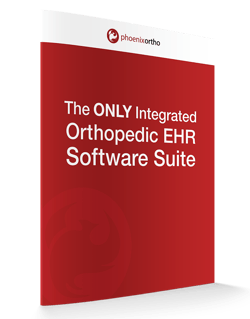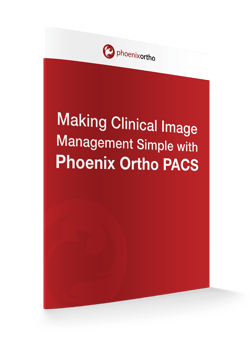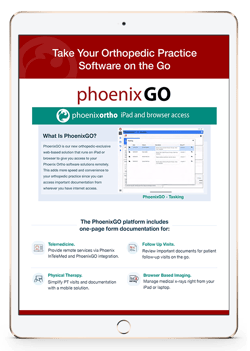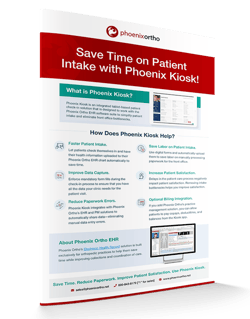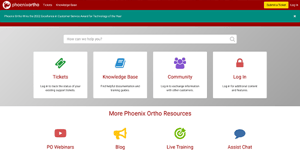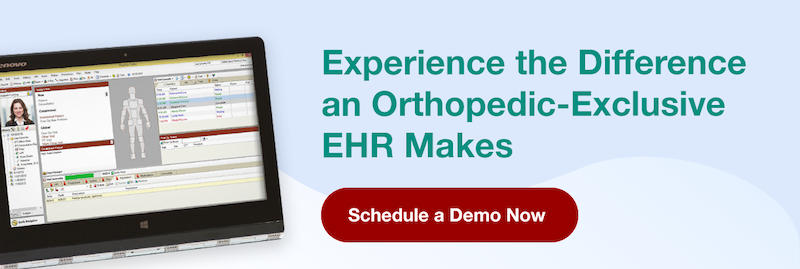EHR implementation is fairly important for orthopaedic practices throughout the country. Without a successful EHR implementation project plan, orthopaedic clinics may find that their EHR software goes underutilized, wasting both the money spent on EHR adoption and the potential return on investment (ROI) that the software can generate when used appropriately.
To help your orthopaedic practice improve its EHR implementation strategy, here’s a guide to implementing a new EHR solution:
The Basic EHR Implementation Steps
The American Medical Association (AMA) outlines several separate stages of EHR implementation, including:
- Create an Implementation Team
- Configure the Software
- Identify Hardware Needs
- Transfer Data
- Optimize Pre-Launch Workflows
- Consider the Room Layout
- Decide on the Launch Approach
- Initiate a Training Plan
Here’s what each of these steps may involve:
1: Creating an EHR Implementation Team
When you’re adopting a new software into the practice, there needs to be someone held accountable for ensuring that the software is properly installed and integrated into your clinic’s existing workflows.
Without someone in charge of your EHR implementation project plan, the odds of the EHR being successfully integrated into your practice are greatly reduced. The AMA outlines three key roles to fill on the EHR implementation specialist team:
- Lead Physician. A physician, preferably who is in practice, that can liaise between the EHR software’s “front line” users (nurses, doctors, etc.) and the clinic’s technical and administrative staff.
- Project Manager. This is the person who will work directly with the vendor and practice staff to ensure that everyone stays focused on their timelines and objectives in the EHR implementation project plan.
- Super Users. A super user is the clinic’s in-house expert on the new EHR software. There should be several of these super users who are able to configure the EHR software, create templates and forms, and help others work the EHR into their workflows. Extensive training is a must for creating super users in your orthopaedic practice.
2: Configure the Software
Even an orthopaedic-specific EHR software will most likely need some configuration to best meet your practice’s needs. However, many EHR vendors simply leave a practice with a license for their software and call it a day. This is not conducive to an effective EHR implementation project plan.
Configuring a newly-adopted EHR software can help you improve how well it integrates with your practice’s existing workflows—and thus improve the amount of time and money it helps you save later on. Having super users in your practice is crucial for ensuring that the software is properly configured and utilized.
3: Identify Your Hardware Needs
What kinds of hardware do you need to get the most out of your EHR implementation? Does every room in the practice need a tablet for doctors to log into the software from? What system specifications does the software require to run? Can orthopaedic doctors log in remotely? How many Wi-Fi connection points does your practice need to provide reliable internet access in every room of the facility?
Answering all of these questions is a crucial part of forming your EHR implementation project plan. An EHR implementation specialist should be able to help answer these questions.
4: Transfer Data
This can be one of the most difficult and drawn-out portions of the EHR implementation process. The transfer of data from an old recordkeeping solution to an EHR software may require specialist staff to ensure that no critical data is missing after the transfer.
It can be useful to have a third-party specialist vendor on hand to perform the transfer. Preferably, this vendor should be able to help with both:
- Practice management (PM) data, such as patient demographics, guarantors, insurance, etc.; and
- EHR data, including clinical data from the patient chart.
There are also legal considerations that may vary from one state to the next. These state laws may require practices to maintain access to their old records. Plus, the healthcare practice will need all of this data to ensure a smooth transition from the legacy system/vendor to the new one.
5: Optimize Orthopaedic Clinic Workflows Prior to Launch
While configuring the EHR software to smoothly integrate it with your clinic’s existing workflows is important, it may be necessary to tweak those workflows as well. For each step of the process, you may need to examine whether the process:
- Is necessary (because of regulatory obligations, patient safety requirements, or to collect payment);
- Adds value for the patient;
- Can be done in a different order more efficiently; or
- Is being assigned to the person who has the right skills.
Simply assuming that adopting an EHR software will fix any issues can be counterproductive. As pointed out by the AMA, “Problems resulting from inefficient workflows or insufficient support staff will be exacerbated during the implementation of EHR.”
6: Consider Your Room Layouts
The AMA makes a specific recommendation to consider the placement and facing of any computer terminals that may be placed in examination rooms to optimize doctor-patient communication. As they note: “If the staff and physician must look over their shoulder to see the patient while using the computer, patient communication and engagement suffer.”
Placing computer terminals and orienting them so users can face the patient while asking questions can improve communication and patient satisfaction. Alternatively, orthopaedic doctors can use portable tablets to enter the info into the EHR, or have an assistant enter data on the computer for them while performing their examinations.
7: Settle Your EHR Implementation Strategy
Will your clinic convert to adopting the new EHR software all at once, or gradually shift from the old system to the new one over time? In the vast majority of cases, we recommend the “big bang” approach to EHR implementation that gets it all done at once. By pulling the proverbial “band aid” off quickly, you can minimize the time wasted on transitioning from one system to the next.
This approach is often the best for making a clean break with the old system quickly.
8: Initiate Training
One of the most critical EHR implementation steps is training the people in your orthopaedic clinic to become experts in the use of the EHR. In particular, you want to create multiple “super users” in your organization who can configure the software and instruct others to become EHR implementation specialists.
Here, it can help to find an EHR vendor that has a detailed onboarding process that includes super user training. Ideally, you would have at least one “super user” for each role in your orthopaedic practice (nurse, physician, assistant, lab tech, receptionist, etc.) to train other people in a similar role to use the software in the future.
You may also want to create an ongoing training strategy for ensuring that any new additions to your practice’s staff are cognizant of the EHR software and how it works.
How Phoenix Ortho Makes the Different Stages of EHR Implementation Easy
The Phoenix Ortho team knows that adopting a new EHR solution can be difficult—even if you’re already using a different EHR. That’s why Phoenix Ortho has developed a comprehensive EHR implementation process to help smooth the transition for orthopaedic organizations of all sizes.
There are five distinct stages of EHR implementation in Phoenix Ortho’s personalized process:
- Assigning a Dedicated EHR Implementation Specialist. A member of the Phoenix Ortho team is assigned as a dedicated EHR implementation specialist for your orthopaedic practice. This specialist will work with your clinic’s administrators to learn your current process and how the Phoenix Ortho EHR solution can be used to improve them. They will also be on hand to answer any questions and provide customer support to minimize the headaches related to different EHR implementation steps.
- Identifying and Training Super Users. Phoenix Ortho uses a “train the trainer” model when it comes to EHR implementation. We focus on identifying potential super users in your practice who can then train each other user in turn. These leaders will get to know the Phoenix Ortho software inside and out so they can configure it and train others in its use with ease. This helps to future-proof your organization by letting your staff handle teaching future additions to your clinic’s staff.
- Ongoing EHR Implementation Support. Rather than just throwing a software license at your IT guy and wishing you luck, your EHR implementation specialist will stay on as an ongoing line of support for your team. This specialist will provide ongoing live training classes and answer questions moving forward, even after the initial implementation period is over. We also provide a full knowledge base of FAQs, past live training records, and help articles for any questions that may arise.
- Onsite EHR Implementation Visit. During the week or so leading up to the final implementation of your EHR software, your EHR implementation specialist will make an in-person visit to your clinic. During this visit, they’ll go over any final questions and issues you have, and help your orthopaedic practice’s staff test out the EHR’s capabilities. There will also be PM trainers onsite for the final “go-live” procedure to help with training and implementation tasks.
- Flexible Post Implementation Checkups. We’ll schedule post-implementation checkups with your clinic to verify that you’re getting the most you can out of your EHR software. During these in-person tune-ups, we can provide extra training and advice for using the EHR to its fullest. The scheduling for these checkups is flexible so you can arrange them when they’re most convenient to your clinic’s schedule. As an added bonus, we don’t charge you for the time spent on-site—it’s a part of our free lifetime support (though some travel fees may apply).
- Free Lifetime Training Support. We provide ongoing training in the Phoenix Ortho platform at no additional cost. In addition to free training, we create online webinars detailing the proper use of all aspects of our software. Our “Learning Library” provides 24/7 access to our webinars.
Does your orthopaedic practice need a new EHR solution to help save time and money? Schedule an online demo of Phoenix Ortho’s EHR software to see how it can help your practice now!
Schedule a 1:1
Get in touch with Phoenix Ortho to learn more about how you can save time, money, and mouse clicks with an orthopedic-specific EHR.





